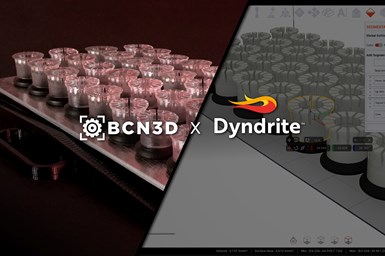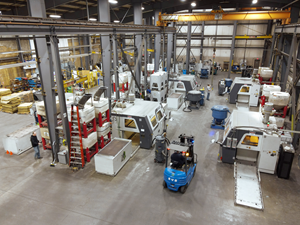Dyndrite Powers BCN3D’s High-Viscosity, Production-Oriented VLM System
The collaboration brings users high-performance, end-use resin part printing with GPU-powered automated production software.
BCN3D is partnering with Dyndrite to use its software to power BCN3D’s Viscous Lithography Manufacturing (VLM) systems. The collaboration is said to boost productivity and automation for VLM users and provide software for unlocking manufacturing autonomy. This collaboration is another example of how machine builders are using the Dyndrite Application Development Kit (ADK) for the development of software applications to drive their machine hardware.
The collaboration brings VLM users high-performance end-use resin part printing with GPU-powered automated production software. The configuration aims to deliver unparalleled productivity and automation for single and multimaterial polymer parts.
The VLM system features a lithography-based 3D printing process that uses high-viscosity resins to produce high-performance parts both rapidly and affordably. Unlike other resin technologies, the company says VLM can process resins 50 times more viscous than the industry standard, enabling formulations with a wider range of ingredients and modifiers to achieve previously unattainable thermal and mechanical properties. BCN3D is partnering with Arkema and Henkel to provide unique material properties and applications. To date, more than 500 companies have registered as early adopters through the VLM Technology Adoption Program (TAP).
Dyndrite provides an accelerated computation engine (ACE) and ADK to hardware and software vendors, creating industrial-focused digital manufacturing solutions. The company says its GPU-powered tool kit enables the creation of next-generation solutions that support extremely large datasets, provide high-resolution output and automated print preparation. Its core environment provides Python APIs for scriptable Build Recipes and third-party app integration. A plug-in mechanism enables third-party extensions to the Dyndrite base capabilities.
Through BCN3D TAP, the company has gained significant insights into numerous multimaterial, multiproperty and water-soluble applications, from experienced engineers across various industries. Specifically, those in manufacturing, automotive, 3D printing services, footwear and dental have shown interest in productivity applications provided by VLM and Dyndrite. Dyndrite says that leveraging its software can address specific software challenges faced in automated AM production.
BCN3D is dispatching the initial VLM systems to designated participants of the VLM TAP. In order to guarantee the most optimal ecosystem and a streamlined workflow, BCN3D researched leading software providers to control VLM units and placed their trust in the cutting-edge Dyndrite’s digital manufacturing software.
“BCN3D is thrilled to announce our collaboration with Dyndrite, which marks a momentous occasion for VLM. This step forward will enable customers of the Technology Adoption Program to precisely focus on productivity-oriented applications,” says Roger Antunez, BCN3D general manager. “By coupling this technology with Dyndrite’s advanced software, we believe it will grant manufacturers full control over every stage of their production process.”
Dyndrite says it is excited about the possibilities. “We created the Dyndrite ADK to help machine builders unlock the power of their process and rapidly bring new manufacturing solutions to market,” says Harshil Goel, Dyndrite founder and CEO. “We are excited to see how the VLM technology will be productized with an eye toward manufacturing productivity and multimaterial applications. BCN3D is about to generate some very interesting IP and we are excited to be the maths engine that plays a part in unlocking it.”
- Read about Dyndrite joining NMIS to advance 3D metal manufacturing research. Dyndrite has joined NMIS to help develop build recipes and shareable knowledge in materials process development across all major laser powder bed fusion OEM file formats.
- Learn more about BCN3D’s Lithography 3D Printing. Parts take shape in the open air. Viscous resin is rapidly carried on a laminate to build each layer. LCD screen size, not vat size, is the limit on productivity.
Related Content
Looking to Secure the Supply Chain for Castings? Don't Overlook 3D Printed Sand Cores and Molds
Concerns about casting lead times and costs have many OEMs looking to 3D print parts directly in metal. But don’t overlook the advantages of 3D printed sand cores and molds applied for conventional metal casting, says Humtown leader.
Read MoreHow AM Enables Cobot Automation for Thyssenkrupp Bilstein (Includes Video)
The shock absorber maker has responded to its staffing shortages through extensive use of collaborative robots. In-house 3D printing makes this possible by providing the related hardware needed to complete the cobot-automated cells.
Read MoreUltiMaker Targets Light Industrial Applications With 3D Printer Designed for the Factory Floor
The company’s Factor 4 3D printer introduced this week is designed to complement conventional manufacturing equipment including CNC machining and automation.
Read MoreDMG MORI: Build Plate “Pucks” Cut Postprocessing Time by 80%
For spinal implants and other small 3D printed parts made through laser powder bed fusion, separate clampable units resting within the build plate provide for easy transfer to a CNC lathe.
Read MoreRead Next
Postprocessing Steps and Costs for Metal 3D Printing
When your metal part is done 3D printing, you just pull it out of the machine and start using it, right? Not exactly.
Read MoreProfilometry-Based Indentation Plastometry (PIP) as an Alternative to Standard Tensile Testing
UK-based Plastometrex offers a benchtop testing device utilizing PIP to quickly and easily analyze the yield strength, tensile strength and uniform elongation of samples and even printed parts. The solution is particularly useful for additive manufacturing.
Read More3D Printed Polymer EOAT Increases Safety of Cobots
Contract manufacturer Anubis 3D applies polymer 3D printing processes to manufacture cobot tooling that is lightweight, smooth and safer for human interaction.
Read More





















